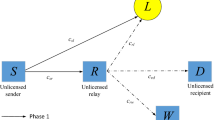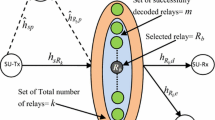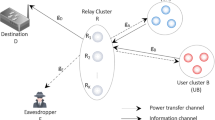Abstract
According to the current challenges of spectrum scarcity, poor wireless communication quality, insufficient energy supply and physical layer security, this paper proposes a secure transmission scheme for multi-hop cognitive relay radio networks based on the underlay mode. When a passive eavesdropper E exists in the transmission environment, secondary source S needs to transmit secrecy information to the legitimate destination D. For the underlay spectrum sharing strategy, S and cognitive relays access the licensed spectrum concurrently with primary transmission by controlling the interference to the primary networks under the interference threshold. In order to achieve better communication between S and D, this paper adds some secondary relays to assist cognitive communication, and these secondary relays are equipped with energy harvesting (EH) devices that will collect energy from the surrounding radio frequency (RF) environment based on the time switching strategy. Then, this energy will supply consumption of decoding and forwarding (DF) the received signal. In the process of forwarding the signal through the secondary relays to D, artificial noise is added to the last relay so that D can successfully receive the message while preventing E from eavesdropping on the secret message. This paper analyzes the influence of target data rates, energy harvesting times, interference thresholds, and other factors on secrecy outage probability (SOP), secrecy capacity (SC), and energy efficiency (EE).










Similar content being viewed by others
References
Ren, P., Wang, J., & Li, S. (2010). A dynamic spectrum access network based on cognitive radio. Journal of Electronics, 27, 577–610.
Yan, J., & Liu, Y. (2017). A dynamic SWIPT approach for cooperative cognitive radio networks. IEEE Transactions on Vehicular Technology, 66(12), 11122–11136.
Kim, S., Cha, H., Kim, J., Ko, S. W., & Kim, S. L. (2019). Sense-and-predict: Harnessing spatial interference correlation for cognitive radio networks. IEEE Transactions on Wireless Communications, 18(18), 2777–2793.
Vishnu, J. B., Lavanya, S., & Bhagyaveni, M. A. (2022). Spectrally efficient cognitive relaying for IoT networks. Wireless Personal Communications, 122, 3433–3443.
Huang, S. W., Chen, H. B., & Zhang, Y. (2012). Optimal power allocation for spectrum sensing and data transmission in cognitive relay networks. IEEE Wireless Communications Letters, 1(1), 26–29.
Ajirak, M., Omidi, M. J., Saeedi-Sourck, H., & Minasian, A. (2017). Optimal power allocation for relay-based cooperative communication systems with energy harvesting. Transactions on Emerging Telecommunications Technologies, 28(8), e3144.
Wang, Z., Zhou, F., Wang, Y., & Wu, Q. (2021). Joint 3D trajectory and resource optimization for a UAV relay-assisted cognitive radio network. China Communications, 18(6), 184–200.
Tao, Z., Zhou, F., Wang, Y., Liu, X., & Wu, Q. (2022). Resource allocation and trajectories design for UAV-assisted jamming cognitive UAV networks. China Communications, 17(2), 125–137.
Li, H., & Zhao, X. (2021). Throughput maximization with energy harvesting in UAV-assisted cognitive mobile relay networks. IEEE Transactions on Cognitive Communications and Networking, 7(1), 197–209.
Li, E., Ma, L., & Hao, S. (2022). Security and reliability analysis of relay selection in cognitive relay networks. Wireless Personal Communications, 123, 3103–3125.
Ye, J., Liu, Z., Zhao, H., Pan, G., Ni, Q., & Alouini, M. (2019). Relay selections for secondary underlay CR systems with energy harvesting. IEEE Transactions on Cognitive Communications and Networking, 5(2), 358–369.
Sudevalayam, S., & Kulkarni, P. (2011). Energy harvesting sensor nodes: Survey and implications. Communication. Surveys Tuts, 13(3), 443–461.
Amirtharajah, R., & Chandrakasan, A. (1998). Self-powered signal processing using vibration-based power generation. IEEE Solid State Circuits, 33(15), 687–695.
Chalasani, S., & Conrad, J. (2008). A survey of energy harvesting sources for embedded systems. IEEE SoutheastCon, 2008, 442–447.
Liu, Y., Mousavifar, S. A., Deng, Y., Leung, C., & Elkashlan, M. (2016). Wireless energy harvesting in a cognitive relay network. IEEE Transactions on Wireless Communications, 15(4), 249–250.
El-Malek, A. H. A., & Zummo, S. A. (2015). A bandwidth-efficient cognitive radio with two-path amplify-and-forward relaying. IEEE Wireless Communications Letters, 4(1), 66–69.
Baofeng, J., Kang, S., Chunguo, L., Zhu, P. W., & Luxi, Y. (2018). Energy harvest and information transmission design in internet-of-things wireless communication systems. International Journal of Electronics and Communications, 87, 124–127.
Khoshafa, M. H., Moualeu, J. M., Ngatched, T. M. N., & Ahmed, M. H. (2021). On the performance of secure underlay cognitive radio networks with energy harvesting and dual-antenna selection. IEEE Communications Letters, 25(25), 1815–1819.
Lee, J., Wang, H., Andrews, J. G., & Hong, D. (2011). Outage probability of cognitive relay networks with interference constraints. IEEE transmission wireless communication, 10(2), 390–395.
Goel, S., & Negi, R. (2008). Guaranteeing secrecy using artificial noise. IEEE transmission wireless communication, 7(6), 2180–2189.
Funding
This work was supported by National Natural Science Foundation of China (Grant No. 61877067), Foundation of Science and Technology on Near-Surface Detection Laboratory (6142414211503).
Author information
Authors and Affiliations
Corresponding author
Additional information
Publisher's Note
Springer Nature remains neutral with regard to jurisdictional claims in published maps and institutional affiliations.
Rights and permissions
Springer Nature or its licensor (e.g. a society or other partner) holds exclusive rights to this article under a publishing agreement with the author(s) or other rightsholder(s); author self-archiving of the accepted manuscript version of this article is solely governed by the terms of such publishing agreement and applicable law.
About this article
Cite this article
Zhang, J., Qi, X., Cai, Y. et al. Secure transmission performance analysis of multi-hop cognitive relay radio networks with energy harvesting and artificial noise aided. Wireless Netw 29, 3829–3837 (2023). https://doi.org/10.1007/s11276-023-03329-1
Accepted:
Published:
Issue Date:
DOI: https://doi.org/10.1007/s11276-023-03329-1




